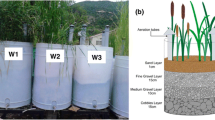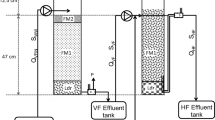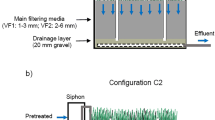Abstract
The effect of step-feeding (untreated wastewater by-pass) on the performance of lab-scale columns simulating a hybrid vertical flow (VF)-horizontal flow (HF) constructed wetland (CW) system was studied. Step-feeding strategies have been adopted in several kinds of CW, but this is the first report about the use of step-feeding in VF + HF hybrid systems treating domestic wastewater. Applied loading rates were 7–11 g BOD5/m2 day and 2.1–3.4 g TN/m2 day (overall system). Removal efficiency reached 98% TSS and COD and 99% BOD5 on average, whilst a 50% by-pass improved TN removal from 31 to 50%. Maximum surface nitrification rate (5.5 g N/m2 day) was obtained in VF unit, whilst maximum denitrification rate (1.8 g N/m2 day) was observed in HF unit. Referred to the overall system, maximum surface nitrification and denitrification rates were 2.2 and 1.6 g N/m2 day, respectively. However, potential nitrifying and denitrifying activities (batch assays) were 15.0 and 58.9 g N/m2 day, respectively. Even at 50% by-pass, operational conditions in HF unit (dissolved oxygen, redox, COD/TN ratio) were not suitable enough for denitrification. However, methane emissions were not observed and nitrous oxide emissions were relatively low.





Similar content being viewed by others
References
Aiyuk S, Verstraete W (2004) Sedimentological evolution in an UASB treating SYNTHES, a new representative synthetic sewage, at low loading rates. Bioresour Technol 93:269–278
Álvarez JA, Ruíz I, Soto M (2008) Anaerobic digesters as a pretreatment for constructed wetlands. Ecol Eng 33:54–67
APHA (2005) Standard methods for the examination of water and wastewater, 21st edn. American Public Health Association/American Water Works Association/Water Environment Federation, Washington
Białowiec A, Davies L, Albuquerque A, Randerson PF (2012) The influence of plants on nitrogen removal from landfill leachate in discontinuous batch shallow constructed wetland with recirculating subsurface horizontal flow. Ecol Eng 40:44–52
Button M, Nivala J, Weber KP, Aubron T, Müller RA (2015) Microbial community metabolic function in subsurface flow constructed wetlands of different designs. Ecol Eng 80:162–171
Carballeira T, Ruiz I, Soto M (2016a) Effect of plants and surface loading rate on the treatment efficiency of shallow subsurface constructed wetlands. Ecol Eng 90:203–214
Carballeira T, Ruiz I, Soto M, (2016b) Methanogenic activity of accumulated solids and gas emissions from planted and unplanted shallow horizontal subsurface flow constructed wetlands. Ecol Eng 98:297–306
Cooper P (2005) The performance of vertical flow constructed wetland systems with special reference to the significance of oxygen transfer and hydraulic loading rates. Water Sci Technol 51(9):91–97
de la Varga D, Díaz A, Ruiz I, Soto M (2013) Avoiding clogging in constructed wetlands by using anaerobic digesters as pre-treatment. Ecol Eng 52:262–269
de la Varga D, Ruiz I, Álvarez JA, Soto M (2015) Methane and carbon dioxide emissions from constructed wetlands receiving anaerobically pretreated sewage. Sci Total Environ 538:824–833
Fan J, Liang S, Zhang B, Zhang J (2013a) Enhanced organics and nitrogen removal in batch-operated vertical flow constructed wetlands by combination of intermittent aeration and step feeding strategy. Environ Sci Pollut Res 20:2448–2455
Fan JL, Wang WG, Zhang B, Guo YY, Ngo HH, Guo WS, Zhang J, Wu HM (2013b) Nitrogen removal in intermittently aerated vertical flow constructed wetlands: impact of influent COD/N ratios. Bioresour Technol 143:461–466
Ferreiro N, Soto M (2003) Anaerobic hydrolysis of primary sludge: influence of sludge concentration and temperature. Water Sci Technol 47(12):239–246
Foladori P, Ruaben J, Ortigara ARC (2013) Recirculation or artificial aeration in vertical flow constructed wetlands: a comparative study for treating high load wastewater. Bioresour Technol 149:398–405
Gaboutloeloe G, Chen S, Barber M, Stöckle C (2009) Combinations of horizontal and vertical flow constructed wetlands to improve nitrogen removal. Water Air Soil Pollut 9:279–286
Hu YS, Zhao YQ, Zhao XH, Kumar JLG (2012) Comprehensive analysis of step-feeding strategy to enhance biological nitrogen removal in alum sludge-based tidal flow constructed wetlands. Bioresour Technol 111:27–35
Hu Y, Zhao Y, Rymszewicz A (2014) Robust biological nitrogen removal by creating multiple tides in a single bed tidal flow constructed wetland. Sci Total Environ 470–471:1197–1204
Kadlec RH, Wallace S (2009) Treatment wetlands, Second edn. CRC Press, Boca Raton
Kim SH, Cho JS, Park JH, Heo JS, Ok YS, Delaune RD, Seo DC (2016) Long-term performance of vertical-flow and horizontal-flow constructed wetlands as affected by season, N load, and operating-stage for treating nitrogen from domestic sewage. Environ Sci Pollut Res 23:1108–1119
Li F, Lu L, Zheng X, Ngo HH, Liang S, Guo W, Zhang X (2014) Enhanced nitrogen removal in constructed wetlands: effects of dissolved oxygen and step-feeding. Bioresour Technol 169:395–402
Mander Ü, Dotro G, Ebie Y, Towprayoon S, Chiemchaisri C, Nogueira SF, Jamsranjav B, Kasak K, Truu J, Tournebize J, Mitsch WJ (2014) Greenhouse gas emission in constructed wetlands for wastewater treatment: a review. Ecol Eng 66:19–35
Meng P, Pei H, Hu W, Shao Y, Li Z (2014) How to increase microbial degradation in constructed wetlands: influencing factors and improvement measures. Bioresour Technol 157:316–326
Pedescoll A, Corzo A, Álvarez E, Puigagut J, García J (2011) Contaminant removal efficiency depending on primary treatment and operational strategy in horizontal subsurface flow treatment wetlands. Ecol Eng 37:372–380
Saeed T, Sun G (2012) A review on nitrogen and organics removal mechanisms in subsurface flow constructed wetlands: dependency on environmental parameters, operating conditions and supporting media. J Environ Manag 112:429–448
Song X, Ding Y, Wang Y, Wang W, Wang G, Zhou B (2015) Comparative study of nitrogen removal and bio-film clogging for three filter media packing strategies in vertical flow constructed wetlands. Ecol Eng 74:1–7
Stefanakis AI, Akratos CS, Tsihrintzis VA (2011) Effect of wastewater step-feeding on removal efficiency of pilot-scale horizontal subsurface flow constructed wetlands. Ecol Eng 37:431–443
Tanner CC, Sukias JPS, Headley TR, Yates CR, Stott R (2012) Constructed wetlands and denitrifying bioreactors for on-site and decentralised wastewater treatment: comparison of five alternative configurations. Ecol Eng 42:112–123
Thiere G, Stadmark J, Weisner SEB (2011) Nitrogen retention versus methane emission: environmental benefits and risks of large-scale wetland creation. Ecol Eng 37:6–15
Torrijos V, Gonzalo OG, Trueba-Santiso A, Ruiz I, Soto M (2016) Effect of bypass and effluent recirculation on nitrogen removal in hybrid constructed wetlands for domestic and industrial wastewater treatment. Water Res 103:92–100
Vymazal J (2007) Removal of nutrients in various types of constructed wetlands. Sci Total Environ 380:48–65
Vymazal J (2013) The use of hybrid constructed wetlands for wastewater treatment with special attention to nitrogen removal: a review of a recent development. Water Res 47:4795–4811
Wang Y, Yang H, Ye C, Chen X, Xie B, Huang C, Zhang J, Xu M (2013) Effects of plant species on soil microbial processes and CH4 emission from constructedwetlands. Env Pollut 174:273–278
Wang Z, Liu C, Liao J, Liu L, Liu Y, Huang X (2014) Nitrogen removal and N2O emission in subsurface vertical flow constructed wetland treating swine wastewater: effect of shunt ratio. Ecol Eng 73:446–453
Wu S, Zhang D, Austin D, Dong R, Pang C (2011) Evaluation of a lab-scale tidal flow constructed wetland performance: oxygen transfer capacity, organic matter and ammonium removal. Ecol Eng 37:1789–1795
Wu S, Kuschk P, Brix H, Vymazal J, Dong R (2014) Development of constructed wetlands in performance intensifications for wastewater treatment: a nitrogen and organic matter targeted review. Water Res 57:40–55
Wu S, Wallace S, Brix H, Kuschk P, Kirui WK, Masi F, Dong R (2015) Treatment of industrial effluents in constructed wetlands: challenges, operational strategies and overall performance, a review. Environ Pollut 201:107–120
Yan C, Zhang H, Li B, Wang D, Zhao YJ, Zheng Z (2012) Effects of influent C/N ratios on CO2 and CH4 emissions from vertical subsurface flow constructed wetlands treating synthetic municipal wastewater. J Hazard Mater 203-204:188–194
Yang Y, Zhao YQ, Wang SP, Guo XC, Ren YX, Wang L, Wang XC (2011) A promising approach of reject water treatment using a tidal flow constructed wetland system employing alum sludge as main substrate. Water Sci Technol 63(10):2367–2373
Zapater-Pereyra M, Ilyas H, Lavrni S, van Bruggen JJA, Lens PNL (2015) Evaluation of the performance and space requirement by three different hybrid constructed wetlands in a stack arrangement. Ecol Eng 82:290–300
Zhao YJ, Liu B, Zhang WG, Ouyang Y, An SQ (2010) Performance of pilot-scale vertical-flow constructed wetlands in responding to variation in influent C/N ratios of simulated urban sewage. Bioresour Technol 101:1693–1700
Zhu H, Yan B, Xu Y, Guan J, Liu S (2014) Removal of nitrogen and COD in horizontal subsurface flow constructed wetlands under different influent C/N ratios. Ecol Eng 63:58–63
Acknowledgements
Project CTM2011-28384 founded by the Spanish Department of Science and Innovation.
Author information
Authors and Affiliations
Corresponding author
Additional information
Responsible editor: Boqiang Qin
Rights and permissions
About this article
Cite this article
Torrijos, V., Ruiz, I. & Soto, M. Effect of step-feeding on the performance of lab-scale columns simulating vertical flow-horizontal flow constructed wetlands. Environ Sci Pollut Res 24, 22649–22662 (2017). https://doi.org/10.1007/s11356-017-9925-1
Received:
Accepted:
Published:
Issue Date:
DOI: https://doi.org/10.1007/s11356-017-9925-1




